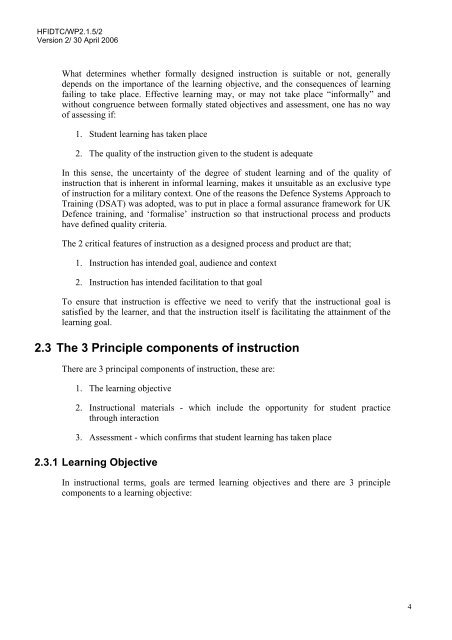E-learning Instructional Design Guidelines - Human Factors ...
E-learning Instructional Design Guidelines - Human Factors ...
E-learning Instructional Design Guidelines - Human Factors ...
Create successful ePaper yourself
Turn your PDF publications into a flip-book with our unique Google optimized e-Paper software.
HFIDTC/WP2.1.5/2<br />
Version 2/ 30 April 2006<br />
What determines whether formally designed instruction is suitable or not, generally<br />
depends on the importance of the <strong>learning</strong> objective, and the consequences of <strong>learning</strong><br />
failing to take place. Effective <strong>learning</strong> may, or may not take place “informally” and<br />
without congruence between formally stated objectives and assessment, one has no way<br />
of assessing if:<br />
1. Student <strong>learning</strong> has taken place<br />
2. The quality of the instruction given to the student is adequate<br />
In this sense, the uncertainty of the degree of student <strong>learning</strong> and of the quality of<br />
instruction that is inherent in informal <strong>learning</strong>, makes it unsuitable as an exclusive type<br />
of instruction for a military context. One of the reasons the Defence Systems Approach to<br />
Training (DSAT) was adopted, was to put in place a formal assurance framework for UK<br />
Defence training, and ‘formalise’ instruction so that instructional process and products<br />
have defined quality criteria.<br />
The 2 critical features of instruction as a designed process and product are that;<br />
1. Instruction has intended goal, audience and context<br />
2. Instruction has intended facilitation to that goal<br />
To ensure that instruction is effective we need to verify that the instructional goal is<br />
satisfied by the learner, and that the instruction itself is facilitating the attainment of the<br />
<strong>learning</strong> goal.<br />
2.3 The 3 Principle components of instruction<br />
There are 3 principal components of instruction, these are:<br />
1. The <strong>learning</strong> objective<br />
2. <strong>Instructional</strong> materials - which include the opportunity for student practice<br />
through interaction<br />
3. Assessment - which confirms that student <strong>learning</strong> has taken place<br />
2.3.1 Learning Objective<br />
In instructional terms, goals are termed <strong>learning</strong> objectives and there are 3 principle<br />
components to a <strong>learning</strong> objective:<br />
4
















